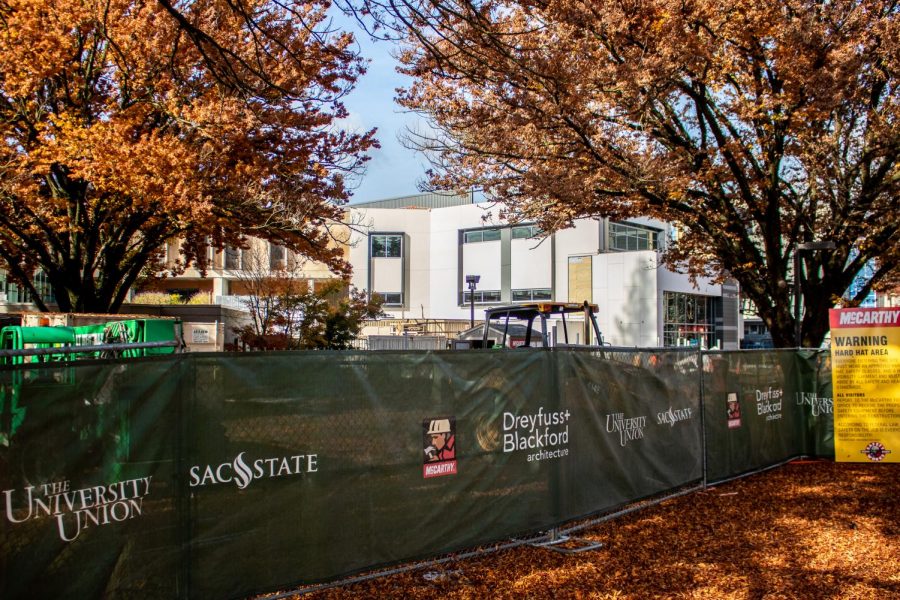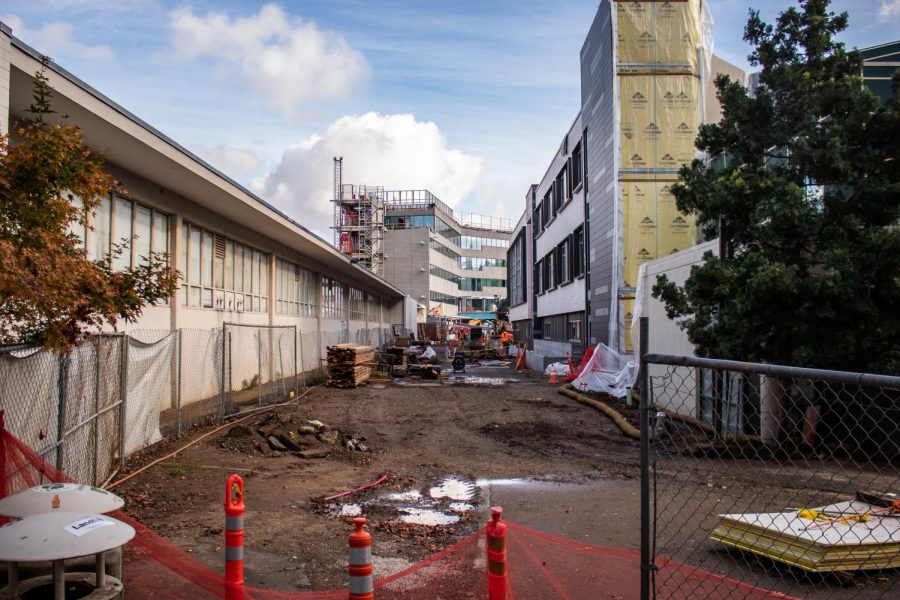New law will require automated defibrillators in renovated buildings
University officials say Sacramento State won’t be significantly affected
Rudy Obstaculo – The State Hornet
Crews work on the the University Union expansion and Science II construction projects at Sacramento State on Friday, Nov. 30. Construction costs on campus have been up and coming for the past two years.
A new law signed by Gov. Jerry Brown in September will eventually require buildings that undergo substantial renovations to install automated external defibrillators, also known as AEDs.
The author of the bill, Sen. Jerry Hill (D-San Mateo) released a statement pointing out the advantages of AEDs after the governor signed the bill into law.
“The life-saving potential of an AED is clear,” Hill said. “The single most effective intervention during sudden cardiac arrest is the use of an AED.”
RELATED: Jerry Brown signs and vetoes last bills as California governor
An analysis by the Senate Committee on Appropriations found that Senate Bill 1397 would likely cause “unknown, potentially significant costs” for both the University of California and California State University systems.
Officials at Sacramento State, however, say the bill is not likely to directly affect the university.
“We’re not doing the types of tenant improvements or renovations in buildings that would trigger that (requirement,)” said Gary Rosenblum, the university’s associate vice president of risk management, in a telephone interview last Friday.
The new requirements for the defibrillators only apply to buildings that undergo at least $100,000 in tenant improvements or building renovations in one calendar year, or to tenant improvements in public places of assembly, like auditoriums or performing art venues.
Rosenblum said that doesn’t mean there are no AEDs on campus.
“Without this law doing anything to affect us directly, we already have a pretty robust program,” Rosenblum said.
A report prepared earlier this semester for the university’s Executive Safety Committee found that there are currently about 35 defibrillators on campus, although most of them are not accessible to the public.
According to the report, only four AEDs on campus are publicly accessible.
One of those AEDs is located in the University Union. That defibrillator was purchased and is maintained by University Enterprises, Inc., Rosenblum said.
Since the Union is already equipped with an AED, the university will not be required by state law to add a new one despite their ongoing renovation.
According to the text of SB 1397, “If there is an existing AED in the common area of the structure, the requirements … are met without the installation of another AED.”

Construction crews work on the the University Union expansion project at Sacramento State on Friday, Nov. 30. The University Union already has an AED inside, so the university will not be required to add a new one as part of the expansion.
A draft of the Executive Safety Committee report, available on the university website, recommended that AEDs be installed in every building on campus.
The report that was made to the Executive Safety Committee recommended that AEDs be placed in high hazard, high traffic areas as well as areas where people might have elevated heart rates, like the gym.
Rosenblum said the university is planning to add defibrillators in those areas, not because of any new law, but simply because the university has decided to upgrade its AED capabilities.
Each new defibrillator will cost the university about $1,730 to purchase and install, not including ongoing maintenance costs, according to the report.
The report notes that there are already AEDs in The WELL. Rosenblum, who chairs the Executive Safety Committee, said in the interview that there are also AEDs in the athletic trainer offices, near the climbing walls on campus, and near the swimming pool at Yosemite Hall.
Rosenblum also said the Sacramento State Police Department is already equipped with AEDs.
“All of the officers are AED trained, and they carry them in their vehicles,” Rosenblum said. “So whenever there is a call, a 911 call, the police respond within minutes.”
Rosenblum said that the university doesn’t necessarily need to have AEDs in every building on campus.
“The use of AEDs is extremely rare,” Rosenblum said. “AEDs are useful only for a very specific type of medical situation.”
Plus, ongoing maintenance requirements would make having an AED in every building difficult, according to Rosenblum.
“AEDs also come with a commitment to maintenance,” Rosenblum said. “The batteries need to be checked frequently. The batteries need to be replaced, even if they’re not used, every few years.”
There are also single-use pads that need to be replaced every couple years, and whenever the AED is used.
A new battery and pads cost a couple hundred dollars for each unit, Rosenblum said.
“If you have, let’s say, 50 AEDs, it adds up,” he said. There is also the ongoing cost and effort of checking each AED regularly to make sure the battery doesn’t need to be replaced, Rosenblum explained.
Even considering the cost of an individual defibrillator and the cost of ongoing maintenance, Rosenblum said the new requirements will not be a significant burden to the university.
“If renovating a building means we have to add an AED, that’s totally easy to do. We’re not going to worry about that,” Rosenblum said. “We’ll follow the law if we have that kind of a renovation. We just don’t do a lot of that kind of major building revamping.”
Your donation will support the student journalists of Sacramento State University. Your contribution will allow us to purchase equipment and cover our annual website hosting costs.


























































































































